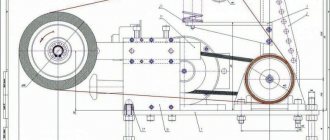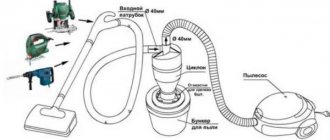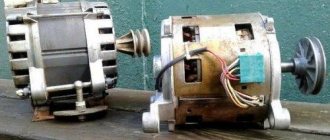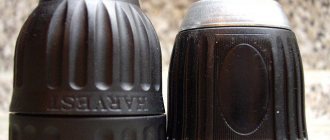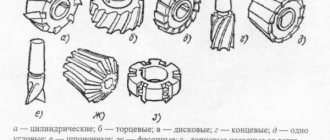Villagers, who lack city-dwelling amenities and central heating, must heat their homes with traditional wood-burning stoves. And firewood is things made of wood, that’s why they are called firewood. To load the stove with them, you need to cut a long log into logs, and they, in turn, split them into logs. You can chop wood with an axe, but it is much more convenient to use a homemade mechanical wood splitter for chopping.
DIY mechanical wood splitter
History of the woodcutter. A few words about the evolution of the instrument
The most labor-intensive stage of the entire firewood preparation process is splitting the logs. And for this purpose a tool such as a wood splitter is used. In Rus', a woodcutter was a person who chops wood for a stove with a cleaver or an ax. Of course, at the age of 20, 30 or 40, a man can easily cope with this. Take a good swing, hit hard - and that's it! But by the age of 50, even for a person accustomed to physical labor since childhood, it is no longer easy to swing a cleaver, and therefore the need arose for a device for chopping wood that could make the work easier.
Ax device
Today it is easy to acquire a wood splitter. It can be bought in a store (similar tools are produced by many companies), but the average rural resident does not always have the means to purchase it.
In this case, there is only one way out - to make this most useful device with your own hands ; fortunately, you can find a great many photographs of a homemade wood splitter on the Internet.
DIY mechanical spring wood splitter
Note! Mechanical wood splitters come in various types - manual, spring, cone. However, they all make work much easier (to a greater or lesser extent).
The wood splitter has evolved to this form
Types of wood splitters
According to the working direction (location of the log to be split), they are made:
- Horizontal type . The log (the sawn-off part of the log) is located on a horizontal gutter. The splitting scheme is as follows: either the log moves (advanced by the pusher towards the knife of the mechanism), and the knife is fixed in place, or vice versa - the log lies in place, and the knife moves towards it.
- Vertical type. Part of the log is placed vertically, and the knife moves and presses on it from above. Such mechanisms are more productive, but sometimes it is necessary to support the splitting log with your hands, which requires careful adherence to safety precautions. But they require less operating space. As a rule, this type of work direction is performed by professional wood splitters.
- Mixed type . It combines the capabilities of both horizontal and vertical process automation. Used in the professional field.
Depending on the motor power source:
1. Models with electric motors , which drive a hydraulic pump. These are the simplest mechanisms for chopping wood. They are easy to use, environmentally friendly - they can even be used indoors. They do not require specialized maintenance; they are quickly and easily prepared for use. These are the models that are used for domestic needs. They have only one drawback - they do not always have access to the power supply network.
2. Models with gasoline (diesel) engines . They can be more powerful than electrically driven mechanisms. Such machines are used not only by professional loggers, but also by craftsmen in summer cottages.
3. Tractor-driven wood splitters . It is connected to the tractor's hydraulic system, or to its power take-off shaft. These mechanisms are powerful and durable. Their uses are forestry, farms, commercial enterprises.
4. With combined engines . The following combinations of wood splitter drive sources are produced:
- Tractor drive and electric motor
- Tractor drive and gasoline engine
Depending on the principle of operation, cleavers are divided into:
- Hydraulic wood splitters. Using a hydraulic pump, the knife presses on the log with enormous force and splits it. The price of such a wood splitter, a household mechanism, depending on the country of manufacture, ranges from 9,500 rubles. up to 32,000 rubles, depending on engine power and working direction device.
- Cone splitter. Instead of a knife, a threaded cone is used, which, rotating, is screwed into the log and splits it. Based on this principle of operation of the wood splitter, it is easiest to make a homemade wood splitter. There is practically nothing for him to break. The cone thread is enough to split 2000 m3 of birch firewood, which is impressive. The only negative is that a screw wood splitter requires a more powerful electric motor than a hydraulic one. The price of such a mechanism, depending on the type of engine, ranges from 17,500 rubles. up to 38,000 rub.
Depending on the ability to move, wood splitters are divided into:
- Stationary mechanisms. As a rule, heavy wood splitters come in this design.
- Mobile mechanisms. The presence of special transport wheels makes it possible to move the machine to the required location without any difficulty.
The nuances of splitting wood
So, we found out that firewood can be split in various ways. As a rule, for this purpose, blows are made with an ax in order to split a sawn piece of log, and the blows are applied to the end.
A massive wedge (and the ax is shaped like a wedge) is driven into the log. If it is soft and without knots, then the wedge will go inside even with relatively little physical effort. The wood fibers will move apart under the influence of tangential forces, and the body of the log will split into two parts.
Chopping wood with an ax
In the case of a small angle at the apex, the tangential forces will be smaller, but the wedge will penetrate deeper inside. However, the destructive force will not be enough, and the ax will jam in the crack that appears. And if the angle is less acute, the tangential forces will increase and the wood, as a result, will split.
On a note! The viscosity of wood will depend on a number of factors. It has been laboratory proven that the wedge angle at the apex for most wood species should be 25-30°. In this case, the chopping properties of the wedge-shaped tool will be the best.
Impact strength of wood
If the wedge penetrates slowly, then the energy accumulated during the swing and subsequent impact is no longer a determining factor. In this case, the connections between the fibers are broken after certain values are reached during implementation. According to research, the optimal tip angle for manual wood splitters is 30-38°. Then the connections will be broken with less effort. Although some types of wood can “resist” - for example, cherry, elm, apple tree.
What should the logs be like?
Pine, ash, oak and some other species split with a slight penetration of the wedge.
Important! The magnitude of the forces also depends on the length of the block. The shorter the log, the less resistance the wood will provide when splitting. As a rule, this length is determined by the depth of the firebox, because the firewood in the stove must be positioned in such a way that the door closes smoothly.
Hydraulic wood splitter
GOST 3243-88. Firewood. Specifications . Downloadable file (click the link to open the PDF in a new window).
GOST 3243-88
Screw electric wood splitter
As practice shows, the most effective and in demand on the construction market is a screw-type wood splitter with an electric motor, with horizontal or vertical loading of logs.
Advantages of a wood splitter with an electric motor
A screw (cone) electric wood splitter has a number of advantages, such as:
- ease of use and minimal human participation in its work - limited to turning on the button on the engine, monitoring the ongoing process, feeding logs and transferring chopped logs to a place protected from precipitation (even a child/teenager and the elderly can handle this);
- high speed and productivity - a wood splitter with an electric motor works faster than a person and almost uninterruptedly, which allows you to chop a large amount of firewood in a short period of time;
- the effectiveness of a screw (conical) splitting ax lies in the fact that during the forward movement it splits the log into several logs at once;
- the possibility of operation at any time of the year and day - for this it is necessary to monitor its serviceability, carry out preventive maintenance (tint, lubricate, etc.);
- Quite low cost compared to models that use engines running on expensive gasoline, diesel fuel or diesel fuel.
Disadvantages of an electric wood splitter
The disadvantages of an electric wood splitter include:
- quite complex (compared to mechanical) design;
- dependence on the presence of a nearby electrical network (preferably three-phase 320 volts);
- high energy consumption when using a powerful engine;
- the possibility of breakage when splitting logs of birch, oak and other species with intertwined fibers;
- the need to carefully observe safety requirements (installing it on a rubberized mat, clothing and gloves/mittens must fit snugly to the body so that they do not get pulled into the moving propeller).
Types of manual wood splitters
The most popular are manual wood splitters (also called kinetic), which operate using simple physical principles and do not require special physical capabilities. Here are the main types of devices:
- crowbar cleaver (the log on which the cleaver is installed is split with a sharp forward movement using a special crowbar rod);
Wood splitter
- spring (there is a lever of force, the method of a weighted working element is used);
Do-it-yourself spring-loaded manual wood splitter
- with a manual drive (there is a special cabinet with a blade oriented upward on it. The log is placed on the blade and is easily split in two using, for example, a sledgehammer);
- rack and pinion (there is a special rack with notches, which is a pushing element).
Homemade rack wood splitter
A tool for splitting firewood with a foot pedal
If you often burn wood, you have already repeatedly encountered the problem of cutting wood. To simplify the process as much as possible, you can use manual mini-wood splitters - such as Greenween, Strela, Kolundrov. Such devices will help you quickly and efficiently split the most “complicated” logs, and even women (including the elderly) can operate them.
It’s convenient to use these mini wood splitters
Even women can use this wood splitter
Important! When choosing a wood splitter, be guided by the volume of wood being harvested. Also give preference to proven and non-hazardous tools. Let's take a look at the mini wood splitters mentioned earlier.
Greenween
The device has basic and multifunctional modifications. But the device in both cases is identical: a wide blade made of high-strength steel is fixed to the frame. Ribs are melted onto the edges of the blade - special hard plates that separate the cracked log into parts.
Photo of Greenween wood splitter
Wood splitter GreenWeen
The basic model differs from the multifunctional one in the diameter of the lumps that can be split. With the help of the second version of the device, you can cope with even the thickest blocks. It has a special semicircular plate into which the free end of the log rests.
The main advantage of the Greenween log splitter is its safety
The basic modification is equipped with a solid metal ring that acts as a side support. The inner diameter of the ring indicates the maximum thickness of the chocks. The Greenween wood splitter is carefully designed and ergonomic, and therefore working with it is easy and not tiring. It weighs 5.7 kg, its height is only 35 cm. The multifunctional version of the tool weighs even less - 4.8 kg.
The basic modification of the wood splitter has a solid metal ring
You will probably be interested in: DIY isolon lamp
"Arrow"
This is a hand tool, something between a construction crowbar and a splitting axe. As a result, it can be used for many purposes, not just for chopping wood. For example, for knocking down ice or frost, for loosening frozen or dense soil during construction.
Manual wood splitter "Strela"
The design of the tool is telescopic, there is a working element (a long rod with a handle) and a striking element (a pointed cone at the bottom). The handles are rubber, so the tool does not slip during use. The principle of the work itself is simple: the rod rises and falls onto the log, as a result of which it splits.
This tool is multifunctional
Using the "Arrow" you can split very heavy and thick logs. The tool is easy to use and works great on soft wood. As for other advantages, these include:
- small sizes;
- reduction of applied physical force during work;
- versatility (we talked about this above).
"Strela" can split the heaviest and thickest logs
The wood splitter is small in size,
but there are disadvantages, including:
- unattractive appearance;
- load on the lower back (this is not going away);
- high risk of injury (the wedge can slip off the log - usually of small diameter, and chips or the log itself can bounce off);
- the appearance of calluses (even despite the fact that the handles are rubber).
There is a risk of injury when working with a wood splitter.
Kolundrov
This is an alternative to Strela, but safer to use. Kolundrov has high performance, looks quite nice and is safe to use. The lower part is stable, it has holes for fastening, thanks to the metal ring on top, chips and split logs do not fly off to the sides, which means they cannot injure a person.
Manual wood splitter Kolundrov
With the help of sharpened knives, even knotty and wet logs can be easily broken.
Table. Average market prices for popular manual wood splitters in 2019-2020.
| Name of the wood splitter | Average cost, rub. |
| Greenween | 5 650 |
| "Arrow" | 1 690 |
| Kolundrov | 5 800 |
Types of wood splitter engines
Log splitters also vary in engine types. Depending on what they work on, wood splitters are:
- electrical;
- gasoline;
- on tractor traction.
An electric wood splitter is ideal for domestic use. Naturally, for it to work, there must be electricity in the house or area. A wood splitter is a very powerful device, so to avoid knocking out plugs, your wiring must be designed to withstand such loads.
If you are chopping wood outside, be sure to place it on a rubberized mat. If it rains and the log splitter gets wet, it may short out when turned on. Working with any electrical appliances requires compliance with safety requirements. Today it is popular to use household wood splitters with electric motors, because it is very convenient.
A gasoline wood splitter is used for industrial purposes. These are very powerful devices that run on gasoline and have high performance. They are used in large enterprises.
A gasoline-powered wood splitter can be used in non-electrified areas. If you need a large amount of firewood during the construction of a house, you can bring a gasoline wood splitter to such a site.
The latest type of wood splitters are connected to a tractor and powered by its engine. The characteristics of this type of wood splitter are an order of magnitude different from all others. Using the listed devices, you can cut thousands of cubic meters of forest for firewood in a short period. These wood splitters are used by large industrial enterprises that use or sell firewood in large volumes.
Today, manufacturers present wood splitters of various types, which differ in the method of laying logs, operating principles, engine type and other characteristics. A wood splitter is a very necessary thing in the household, but if you do not have the opportunity to purchase one, you can make a wood splitter yourself - there is a detailed description of each model on the Internet. True, a homemade wood splitter is only suitable for domestic purposes; enterprises need to buy devices made by reliable manufacturers.
Features of spring log splitters
A spring-type wood splitter is considered to be a simple-to-use, economical, reliable, and inexpensive tool. It is the result of the modernization of traditional cleavers. When operating a spring log splitter, muscle force is also applied, but to a lesser extent, thanks to the additional load, large lever and the spring mechanism itself.
Spring log splitter is simple and reliable
Mechanics of a spring log splitter
On a note! You can make this wood splitter yourself. The structure in this case will consist of a profile or metal pipe (this will be a lever with a knife at the end), an iron stand and a hinge-type connection. You can use an old shock absorber as a return mechanism.
Kinematic diagram of a spring splitter
Let's look at an example of how to make a simple spring splitter yourself.
How do wood splitters work?
Based on the operating principle, there are several types of wood splitters:
- hydraulic;
- mechanical;
- screw;
- rack and pinion
The mechanical spring log splitter has a simple design, and therefore it is quite easy to use. It is placed on the ground or on a strong floor, a log is placed under the cone of the splitting splitter, it is lifted using the handle, and then the pedal is pressed, and the blade splits the wood. This wood splitter is powered only by human action, which is reinforced by a spring.
A type of mechanical splitter is a gear splitter. The principle of its operation is simple: rotational movements are converted into translational ones, and the cleaver breaks the logs into small firewood. A wood splitter with a gearbox is also called a rack splitter. The rack wood splitter also has a simple design. If you wish, you can make such a rack-and-pinion wood splitter with your own hands - there are enough video and photographic materials in the public domain that tell you step by step how to make this device.
If you don’t know what kind of wood splitter you need, you can choose this model. In order to make your own rack-and-pinion wood splitter, you will need inexpensive materials that are sold in all hardware stores. This design acts on a tree with a force of at least 10 tons, so a rack splitter can cope with any wood. A homemade hydraulic one will cost you more than a rack and pinion one, but in terms of performance they are approximately the same.
A screw splitter is used for sawing small wooden logs. The log is placed in the chute and the screw is screwed into it using the handle. A little effort and the metal drill splits the wood. It takes about a minute to cut one log. This wood splitter is powered by both motor and mechanical action.
The most popular is the hydraulic wood splitter. It really is the best model out there. With its help you can cut any type of wood, including the most durable and even wet ones. This wood splitter consists of a hydraulic cylinder. A log is placed in it, and the cylinder begins to push either it or the blades. The pressure inside is high, so all the work is done very quickly. Due to its high productivity, a hydraulic wood splitter is usually used in large enterprises, but if you have the financial opportunity, you can buy it for your home or cottage.
Spring wood splitter. Step-by-step manufacturing instructions
First, prepare all the necessary tools - in our case these are:
- grinder (as well as cleaning and cutting discs for it);
- tools for marking and measuring;
- welding machine (fortunately, current inverter machines weigh little, are easy to use and allow you to obtain neat welds).
Also prepare the following supplies:
- shock absorber from a passenger car;
- channels;
- steel pipes (diameter from 4 cm to 7 cm);
- profile pipe 3x6 cm (4x6 cm);
- bushing from a car suspension (worn is allowed);
- rail (30-40 cm);
- corner;
- I-beam (No. 12-16).
Step 1. First, prepare a sketch of the future structure. If possible, you can use a special engineering design program that allows you to work out all the details. Here is a rough diagram of the future wood splitter.
Approximate diagram of a do-it-yourself spring log splitter
Step 2. Make a support from a channel, weld a stand to it (the latter is best made from an I-beam, which is highly rigid; such a stand will be difficult to bend even under prolonged loads). For greater stability, weld the jibs to the base. Also, additionally make stops from the pipes to prevent a possible fall of the wood splitter.
Support for the future wood splitter
Step 3. Take the channel and cut out the support for the spring. Cut a square hole in the support, thanks to which the element will be securely fixed to the stand.
Spring support
Step 4. As for the installation height of the support, it depends on the length of the spring used. Also focus on the height of the entire structure and how convenient it will be to use. Thus, it is most convenient to lift the load when it is at waist height (it will rise slightly above the chest).
The installation height of the support is determined
Step 5. Make the jibs necessary to hold the support from the corners. Thanks to this, the supporting surface will not move when the device is dynamically loaded.
Corner jibs
Step 6. Make a cylindrical clamp to secure the bottom of the spring, which will require a small piece of pipe. When choosing the diameter of the pipe, be guided by the internal diameter of the spring so that it does not move during operation.
Cylindrical spring retainer
Step 7. Make a slot in the top of the post, install the bushing there, and then weld the latter. It is important to maintain perpendicularity to the stand. Also make sure that the hub axis is parallel to the ground.
The hub axis must be parallel to the ground
Step 8. Install the shaft into the sleeve. Weld a rocker arm from a channel to it, at the bottom of which install a small piece of pipe. This pipe is necessary to fix the upper part of the spring.
Channel rocker
Step 9. Cut a “window” in the rocker, the dimensions of which depend on the size of the rack itself. Thanks to this, the rocker will move freely.
"Window" in the rocker
Step 10. Weld the profile pipe to the rocker arm, install a chisel on one end. By the way, the chisels are made of hard carbon steel U9 or U10, and therefore the element will last a long time. Then, during operation, the chisel can be easily sharpened using a grinder and a sharpening wheel.
Chisel at the end of a profile pipe
Step 11. Our wood splitter is almost ready. Weld a piece of rail above the chisel, which will act as a weight. Also weld the handle to make it more convenient to use the wood splitter. It is advisable to put rubber elements on them - they will dampen vibrations.
For convenience, a handle is installed on the wood splitter
Note! Lay a piece of large diameter log - it is necessary for the work. Logs for splitting will be installed on it.
Step 12. Check the functionality of the wood splitter. Place the block of wood and, holding it with one hand, lift the cleaver and strike.
The cleaver strikes
Mechanics of splitting wood when a cleaver is inserted into it
Step 13. The cleaver will go down, causing the log to split. If it splits completely, the chisel will go further, but will hit the wooden support, and therefore will not become dull.
Splitting firewood with a spring log splitter
How to make a wood splitter?
Wood splitters for a dacha or a private home are an absolutely necessary thing. But not many can, and even want to, pay tens of thousands of rubles for this assistant. There is an absolutely inexpensive alternative to a factory-made wood splitter.
You can simply buy a threaded cone attachment or ready-made units and assemble the wood splitter yourself. From the diagram it can be seen that the wood splitter-screw consists of a frame on which the engine is mounted. Next, the working cone sits on a shaft, which is driven by the engine through a reduction gearbox.
We must remember that:
- Do not attach the attachment directly to the engine. This is dangerous because the engine speed reaches 3000 rpm.
- The rotation speed of the nozzle should not be less than 250-300 rpm. At a lower speed, the cleaver's productivity is very low.
- A chain or belt drive (it transmits rotation from the motor gearbox to the working cone) must be in a protective casing.
- The electrical part of the wood splitter should be handled by a specialist.
The price of the bearing assembly (the upper part for a homemade wood splitter mechanism) assembled ranges from 4,200 rubles. up to 5600 rubles, depending on the diameter of the working cone.
Video on the topic:
A simple manual wood splitter. Step-by-step manufacturing instructions
Do-it-yourself manual wood splitter
A simpler design, for the creation of which you need to prepare:
- spring from a car;
- metal corner (40 or 50);
- a couple of corner pieces 55 cm long;
- another couple - 15 cm long.
car spring
Metal corner
Two corners of 5 cm each and two more of 15 cm
each Step 1. Take a long corner, mark it on it, stepping back 10 cm from the edges.
You need to retreat 10 cm from the edges
A long corner is marked
Step 2. Step back 1.5 cm from the very corner.
You need to retreat 1.5 cm from the corner
Step 3. Mark the middle 5 cm, as in the photo below.
The middle of the corner is marked at 5 cm
Step 4. After this, take a grinder and trim according to the markings.
Trimming a corner according to the markings
Step 5. Next, take the second long corner, attach it to the already cut one, using the latter as a template.
The cut out corner is used as a template
Step 6. Cut the second long corner in the same way.
The second corner is cut off
Step 7. You should end up with something like this.
The result of the work done
Step 8. Now it's time to start working on the short corners. Take them.
Short corners are taken
Step 9. Weld the long corners to the short ones.
Long corners are welded to short corners
Step 10. Cut a 35 cm long piece from the spring.
A piece of spring is cut off
Step 11: Make the bushing. Take a round piece of wood for this purpose and drill a hole in it for the mounting bolt.
A hole is drilled in the round timber
Step 12. Cut the round timber to the required length - it should be the same as the width between the corners.
The length of the sleeve must correspond to the width between the corners
Step 13. Make a small opening in the spring.
A small opening is machined in the spring
Step 14. Weld the bushing made earlier to it.
The bushing must be welded to the spring
Bushing is welded
Step 15. To connect the spring to the corners, make holes in the latter.
Holes are drilled in the corners
Step 16. Next, take a piece of pipe.
Take a piece of pipe
Step 17. Weld this piece to the spring on the other side.
The pipe is welded to the spring
Step 18. After this, sharpen the spring.
Sharpened spring
Step 19. Assemble all the parts into a single structure.
Assembly of all parts
Build process
Step 20. That's it, the manual wood splitter is ready, you can start testing it.
Testing a homemade wood splitter
Step 21. To make it more convenient to use the wood splitter, in our example it is welded to a pipe that is concreted into the ground.
The wood splitter is welded to a pipe concreted into the ground
This makes the tool easier to use
Video - Simple but effective wood splitter
How to organize the workflow?
Having built a homemade wood splitter, you can safely start chopping firewood. But to make the work easier, it is important to properly organize the entire process. So, the cut fragments should be located on one side at a distance of two or three steps (so as not to get too tired). It is recommended to put chopped firewood in a cart. It has a small volume; a maximum of 30-40 kg of firewood will fit into it.
Firewood chopped with a homemade wood splitter
After each cart is filled, transport the wood and place it on the woodpile. During transportation, by the way, there will be time to take a break from your main work, because a change of occupation is also a rest!
5/5 (7)
